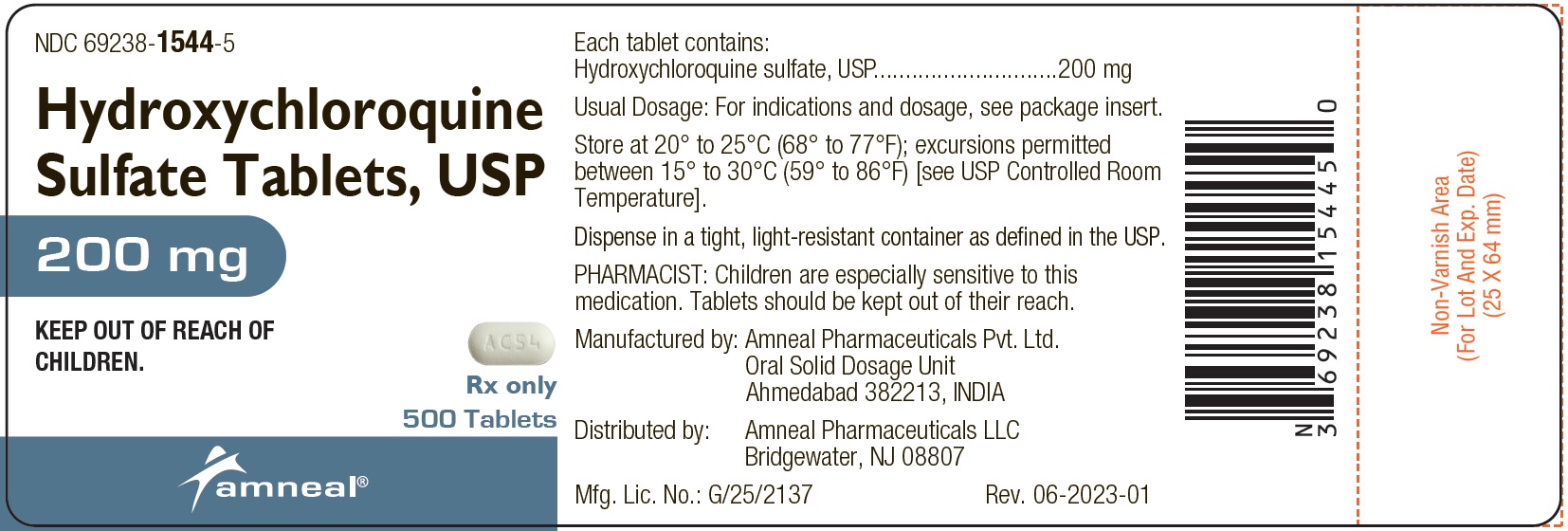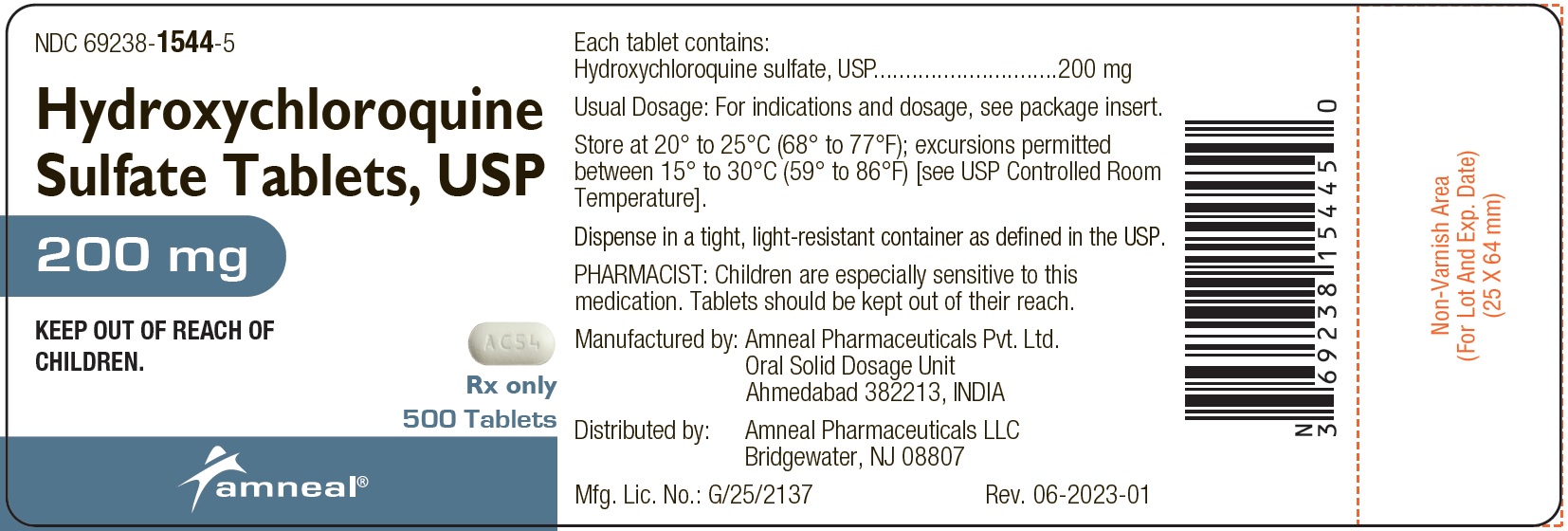5.1 Cardiomyopathy and Ventricular
- Arrhythmias
- Fatal and life-threatening cases of cardiotoxicity, including cardiomyopathy, have been reported in patients treated with hydroxychloroquine ...
5.1 Cardiomyopathy and Ventricular
Arrhythmias
Fatal and life-threatening cases of cardiotoxicity, including cardiomyopathy, have been reported in patients treated with hydroxychloroquine sulfate. Signs and symptoms of cardiac compromise have occurred during acute and chronic hydroxychloroquine sulfate treatment. In multiple cases, endomyocardial biopsy showed association of the cardiomyopathy with phospholipidosis in the absence of inflammation, infiltration, or necrosis. Drug-induced phospholipidosis may occur in other organ systems [see Warnings and Precautions (5.8, 5.11)].
Patients may present with ventricular hypertrophy, pulmonary hypertension and conduction disorders including sick sinus syndrome. ECG findings include atrioventricular, right or left bundle branch block.
Hydroxychloroquine sulfate has a potential to prolong the QT interval. Ventricular arrhythmias (including torsades de pointes) have been reported in hydroxychloroquine sulfate-treated patients. The magnitude of QT prolongation may increase with increasing concentrations of the drug. Therefore, the recommended dose should not be exceeded [see Adverse Reactions (6), Overdosage (10)]. Avoid hydroxychloroquine sulfate administration in patients with congenital or documented acquired QT prolongation and/or known risk factors for prolongation of the QT interval such as:
- Cardiac disease, e.g., heart failure, myocardial infarction.
- Proarrhythmic conditions, e.g., bradycardia (< 50 bpm).
- History of ventricular dysrhythmias.
- Uncorrected hypokalemia and/or hypomagnesemia.
- Concomitant administration with QT interval prolonging agents as this may lead to an increased risk for ventricular arrhythmias [see Drug Interactions (7.1)].
Therefore, hydroxychloroquine sulfate is not recommended in patients taking other drugs that have the potential to prolong the QT interval. Monitor cardiac function as clinically indicated during hydroxychloroquine sulfate therapy. Correct electrolyte imbalances prior to use. Discontinue hydroxychloroquine sulfate if cardiotoxicity is suspected or demonstrated by tissue biopsy.
5.2 Retinal Toxicity
Irreversible retinal damage was observed in some patients treated with hydroxychloroquine sulfate and it is related to cumulative dosage and treatment duration. In patients of Asian descent, retinal toxicity may first be noticed outside the macula.
Risk factors for retinal damage include daily hydroxychloroquine sulfate dosages ≥ 5 mg/kg of actual body weight, durations of use greater than five years, renal impairment, use of concomitant drug products such as tamoxifen citrate, and concurrent macular disease.
Within the first year of starting hydroxychloroquine sulfate, a baseline ocular examination is recommended including best corrected distance visual acuity (BCVA), an automated threshold visual field (VF) of the central 10 degrees (with retesting if an abnormality is noted), and spectral domain ocular coherence tomography (SD-OCT). For patients at higher risk of retinal damage, monitoring should include annual examinations which include BCVA, VF and SD-OCT. For patients without significant risk factors, annual retinal exams can usually be deferred until five years of treatment. In patients of Asian descent, it is recommended that visual field testing be performed in the central 24 degrees instead of the central 10 degrees.
If ocular toxicity is suspected, discontinue hydroxychloroquine sulfate and monitor the patient closely given that retinal changes and visual disturbances may progress even after cessation of therapy.
5.3 Serious Skin Reactions
Serious adverse reactions have been reported with the use of hydroxychloroquine sulfate including Stevens-Johnson syndrome (SJS), toxic epidermal necrolysis (TEN), drug reaction with eosinophilia and systemic symptoms (DRESS syndrome), acute generalized exanthematous pustulosis (AGEP). Monitor for serious skin reactions, especially in patients receiving a drug that may also induce dermatitis. Advise patients to seek medical attention promptly if they experience signs and symptoms of serious skin reactions such as blisters on the skin, eyes, lips or in the mouth, itching or burning, with or without fever [see Warnings and Precautions (5.4, 5.5), Adverse Reactions (6)]. Discontinue hydroxychloroquine sulfate if these severe reactions occur.
5.4 Worsening of Psoriasis
Administration of hydroxychloroquine sulfate to patients with psoriasis may precipitate a severe flare-up of psoriasis. Avoid hydroxychloroquine sulfate in patients with psoriasis, unless the benefit to the patient outweighs the possible risk.
5.5 Risks Associated with Use in Porphyria
Administration of hydroxychloroquine sulfate to patients with porphyria may exacerbate porphyria. Avoid hydroxychloroquine sulfate in patients with porphyria.
Hepatotoxicity Associated with Porphyria Cutanea Tarda
Cases of hepatotoxicity have been reported when hydroxychloroquine was used in patients with porphyria cutanea tarda (PCT). Patients received dosages ranging from 200 mg twice weekly to 400 mg daily. Most of the PCT-related cases presented with marked elevations in transaminases (> 20 times upper limit of the reference range) within days to a month of hydroxychloroquine initiation. In some cases, PCT was diagnosed only after the occurrence of treatment-induced liver injury, when hydroxychloroquine was prescribed for an approved indication. Some of the cases were associated with other risk factors for hepatic injury (e.g., alcohol use, concomitant hepatotoxic medications).
Measure liver tests promptly in patients who report symptoms that may indicate liver injury, such as fatigue, rash, nausea, dark urine, or jaundice. In this clinical context, if the patient is found to have abnormal serum liver tests (e.g., ALT level greater than three times the upper limit of the reference range, total bilirubin greater than two times the upper limit of the reference range), interrupt treatment with hydroxychloroquine sulfate, and investigate further to establish the probable cause.
The safety and effectiveness of hydroxychloroquine sulfate for the treatment of PCT have not been established and hydroxychloroquine sulfate is not approved for this use.
5.6 Hematologic Toxicity
Hydroxychloroquine sulfate may cause myelosuppression including aplastic anemia, agranulocytosis, leukopenia, or thrombocytopenia. Monitor blood cell counts periodically in patients on prolonged hydroxychloroquine sulfate therapy. If the patient develops myelosuppression which cannot be attributable to the disease, discontinue the drug.
5.7 Hemolytic Anemia Associated with G6PD
Deficiency
Hemolysis has been reported in patients with glucose-6-phosphate dehydrogenase (G6PD) deficiency. Monitor for hemolytic anemia as this can occur, particularly in association with other drugs that cause hemolysis.
5.8 Skeletal Muscle Myopathy or Neuropathy
Skeletal muscle myopathy or neuropathy leading to progressive weakness and atrophy of proximal muscle groups, depressed tendon reflexes, and abnormal nerve conduction, have been reported. Muscle and nerve biopsies have shown associated phospholipidosis. Drug-induced phospholipidosis may occur in other organ systems [see Warnings and Precautions (5.1, 5.11)].
Assess muscle strength and deep tendon reflexes periodically in patients on long-term therapy with hydroxychloroquine sulfate. Discontinue hydroxychloroquine sulfate if muscle or nerve toxicity is suspected or demonstrated by tissue biopsy.
5.9 Neuropsychiatric Reactions Including
Suicidality
Suicidal behavior, suicidal ideation, and other neuropsychiatric adverse reactions have been reported in patients treated with hydroxychloroquine sulfate [see Adverse Reactions (6)]. Neuropsychiatric adverse reactions typically occurred within the first month after the start of treatment with hydroxychloroquine and have been reported in patients with and without a prior history of psychiatric disorders.
The risks and benefits of continued treatment with hydroxychloroquine sulfate should be assessed for patients who develop these symptoms. Given the long half-life of the drug, some patients may require several weeks off drug for symptoms to partially or fully abate.
Advise patients to contact their healthcare provider promptly if they experience new or worsening neuropsychiatric symptoms such as depression, suicidal thoughts or behavior, or mood changes.
5.10 Hypoglycemia
Hydroxychloroquine sulfate can cause severe and potentially life-threatening hypoglycemia, in the presence or absence of antidiabetic agents [see Drug Interactions (7)]. Measure blood glucose in patients presenting with clinical symptoms suggestive of hypoglycemia and as adjust the antidiabetic treatment as necessary. Warn hydroxychloroquine sulfate-treated patients about the risk of hypoglycemia and educate them on the signs and symptoms of hypoglycemia; diabetic patients should monitor their blood sugar levels. Advise patients to seek medical attention if they develop any signs and symptoms of hypoglycemia.
5.11 Renal Toxicity
Proteinuria with or without moderate reduction in glomerular filtration rate have been reported with the use of hydroxychloroquine sulfate.
Renal biopsy showed phospholipidosis without immune deposits, inflammation, and/or increased cellularity. Physicians should consider phospholipidosis as a possible cause of renal injury in patients with underlying connective tissue disorders who are receiving hydroxychloroquine sulfate. Drug-induced phospholipidosis may occur in other organ systems [see Warnings and Precautions (5.1, 5.8)]. Discontinue hydroxychloroquine sulfate if renal toxicity is suspected or demonstrated by tissue biopsy.
Close





